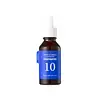What's inside
What's inside
 Key Ingredients
Key Ingredients

 Benefits
Benefits

 Concerns
Concerns

 Ingredients Side-by-side
Ingredients Side-by-side

Water
Skin ConditioningButylene Glycol
HumectantGlycerin
HumectantGlycereth-26
Humectant1,2-Hexanediol
Skin ConditioningBetaine
HumectantPropolis Extract
Skin ConditioningPanthenol
Skin ConditioningCaprylyl/Capryl Glucoside
CleansingPolyglyceryl-10 Laurate
Skin ConditioningCarbomer
Emulsion StabilisingTromethamine
BufferingEclipta Prostrata Extract
Skin ConditioningAdenosine
Skin ConditioningSodium Hyaluronate
HumectantPyrus Communis Fruit Extract
Skin ConditioningLimonene
PerfumingMelia Azadirachta Leaf Extract
Skin ConditioningPolyglyceryl-10 Oleate
Skin ConditioningRosa Damascena Flower Water
MaskingDisodium EDTA
Iris Florentina Root Extract
MaskingCucumis Melo Fruit Extract
Skin ConditioningMelia Azadirachta Flower Extract
Skin ConditioningHedera Helix Leaf/Stem Extract
AntimicrobialCitrus Aurantium Dulcis Peel Oil
MaskingMentha Arvensis Leaf Oil
MaskingWater, Butylene Glycol, Glycerin, Glycereth-26, 1,2-Hexanediol, Betaine, Propolis Extract, Panthenol, Caprylyl/Capryl Glucoside, Polyglyceryl-10 Laurate, Carbomer, Tromethamine, Eclipta Prostrata Extract, Adenosine, Sodium Hyaluronate, Pyrus Communis Fruit Extract, Limonene, Melia Azadirachta Leaf Extract, Polyglyceryl-10 Oleate, Rosa Damascena Flower Water, Disodium EDTA, Iris Florentina Root Extract, Cucumis Melo Fruit Extract, Melia Azadirachta Flower Extract, Hedera Helix Leaf/Stem Extract, Citrus Aurantium Dulcis Peel Oil, Mentha Arvensis Leaf Oil
Water
Skin ConditioningPropanediol
SolventButylene Glycol
HumectantGlycerin
Humectant1,2-Hexanediol
Skin ConditioningGlycyrrhiza Glabra Root Extract
BleachingGlycereth-26
HumectantAmmonium Acryloyldimethyltaurate/Vp Copolymer
Betaine
HumectantCaprylyl/Capryl Glucoside
CleansingPolyglyceryl-10 Laurate
Skin ConditioningDipropylene Glycol
HumectantChamomilla Recutita Flower Extract
MaskingSodium Hyaluronate
HumectantXanthan Gum
EmulsifyingDisodium EDTA
Polyglyceryl-10 Oleate
Skin ConditioningJuniperus Mexicana Oil
MaskingRosa Damascena Flower Oil
MaskingDipotassium Glycyrrhizate
HumectantPogostemon Cablin Leaf Oil
MaskingVetiveria Zizanoides Root Oil
MaskingGuaiazulene
AntimicrobialBeta-Glucan
Skin ConditioningPolyglutamic Acid
Skin ConditioningWater, Propanediol, Butylene Glycol, Glycerin, 1,2-Hexanediol, Glycyrrhiza Glabra Root Extract, Glycereth-26, Ammonium Acryloyldimethyltaurate/Vp Copolymer, Betaine, Caprylyl/Capryl Glucoside, Polyglyceryl-10 Laurate, Dipropylene Glycol, Chamomilla Recutita Flower Extract, Sodium Hyaluronate, Xanthan Gum, Disodium EDTA, Polyglyceryl-10 Oleate, Juniperus Mexicana Oil, Rosa Damascena Flower Oil, Dipotassium Glycyrrhizate, Pogostemon Cablin Leaf Oil, Vetiveria Zizanoides Root Oil, Guaiazulene, Beta-Glucan, Polyglutamic Acid
Ingredients Explained
These ingredients are found in both products.
Ingredients higher up in an ingredient list are typically present in a larger amount.
1,2-Hexanediol is a synthetic liquid and another multi-functional powerhouse.
It is a:
- Humectant, drawing moisture into the skin
- Emollient, helping to soften skin
- Solvent, dispersing and stabilizing formulas
- Preservative booster, enhancing the antimicrobial activity of other preservatives
Betaine is a common humectant (a substance that promotes retention of moisture). It's known to be gentle on the skin and can help balance hydration.
This ingredient is best for improving hydration and soothing irritated skin. Studies also show it helps even out skin tone.
Fun fact: Betaine is naturally created in the skin and body. The kind found within cosmetic products can be either plant-derived or synthetic.
Another name for betaine is trimethylglycine.
Learn more about BetaineButylene Glycol (or BG) is used within cosmetic products for a few different reasons:
Overall, Butylene Glycol is a safe and well-rounded ingredient that works well with other ingredients.
Though this ingredient works well with most skin types, some people with sensitive skin may experience a reaction such as allergic rashes, closed comedones, or itchiness.
Learn more about Butylene GlycolCaprylyl/Capryl Glucoside is an alkyl glucoside. This just means it is creating by reacting alcohol and sugar. It is a cleansing and foaming ingredient.
Caprylyl/Capryl Glucoside helps remove the dirt, oil, and other pollutants from your skin.
Disodium EDTA plays a role in making products more stable by aiding other preservatives.
It is a chelating agent, meaning it neutralizes metal ions that may be found in a product.
Disodium EDTA is a salt of edetic acid and is found to be safe in cosmetic ingredients.
Learn more about Disodium EDTAGlycereth-26 is a synthetic ingredient and polyethylene glycol ether of Glycerin. Glycerin is already naturally found in your skin and helps keep your skin moisturized.
It is a humectant and helps add texture to products. It can make your product thicker.
As a humectant, it helps draw moisture from the air to your skin. This helps your skin stay hydrated.
Learn more about Glycereth-26Glycerin is already naturally found in your skin. It helps moisturize and protect your skin.
A study from 2016 found glycerin to be more effective as a humectant than AHAs and hyaluronic acid.
As a humectant, it helps the skin stay hydrated by pulling moisture to your skin. The low molecular weight of glycerin allows it to pull moisture into the deeper layers of your skin.
Hydrated skin improves your skin barrier; Your skin barrier helps protect against irritants and bacteria.
Glycerin has also been found to have antimicrobial and antiviral properties. Due to these properties, glycerin is often used in wound and burn treatments.
In cosmetics, glycerin is usually derived from plants such as soybean or palm. However, it can also be sourced from animals, such as tallow or animal fat.
This ingredient is organic, colorless, odorless, and non-toxic.
Glycerin is the name for this ingredient in American English. British English uses Glycerol/Glycerine.
Learn more about GlycerinPolyglyceryl-10 Laurate is an ester of lauric acid and Polyglycerin-10.
Polyglyceryl-10 Laurate is a cleansing agent and emulsifier. It helps gather dirt, oil, and other pollutants to be rinsed away. As an emulsifier, it helps prevent ingredients from separating, such as oil and water.
Polyglyceryl-10 Laurate may not be fungal acne safe.
Learn more about Polyglyceryl-10 LauratePolyglyceryl-10 Oleate isn't fungal acne safe.
Sodium Hyaluronate is hyaluronic acid's salt form. It is commonly derived from the sodium salt of hyaluronic acid.
Like hyaluronic acid, it is great at holding water and acts as a humectant. This makes it a great skin hydrating ingredient.
Sodium Hyaluronate is naturally occurring in our bodies and is mostly found in eye fluid and joints.
These are some other common types of Hyaluronic Acid:
Learn more about Sodium HyaluronateWater. It's the most common cosmetic ingredient of all. You'll usually see it at the top of ingredient lists, meaning that it makes up the largest part of the product.
So why is it so popular? Water most often acts as a solvent - this means that it helps dissolve other ingredients into the formulation.
You'll also recognize water as that liquid we all need to stay alive. If you see this, drink a glass of water. Stay hydrated!
Learn more about Water